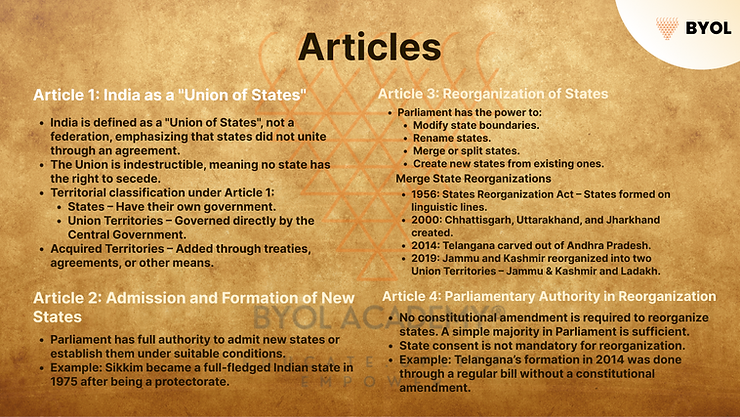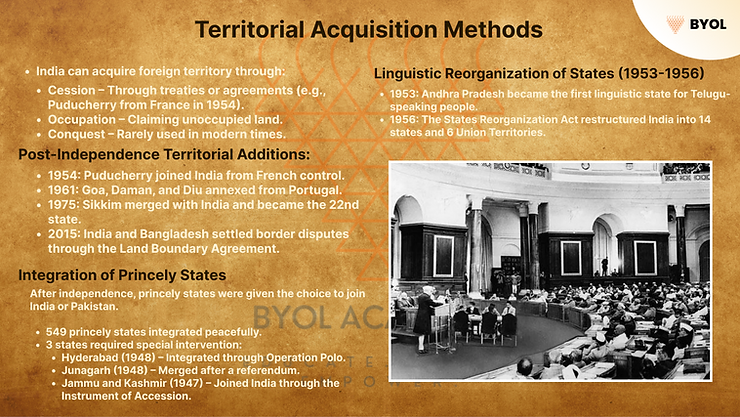Introduction
India’s territorial context continues to evolve, with the reorganization of Jammu & Kashmir in 2019 being the most recent instance of how the Union and its territory may be altered. It is important to comprehend Articles 1-4 to understand India’s federal organization and territorial changes.
Union of States (Article 1)
India has been defined as a “Union of States” and not as a “Federation of States.”
This nomenclature was used for two fundamental reasons (as discussed by Dr. B.R. Ambedkar):
- Not an Agreement-Based Federation – States in India did not unite by an agreement, unlike in the USA.
- Indestructible Union – States cannot leave India; the Union is indivisible.
Territorial Classification under Article 1:
The Indian territory is divided into three groups:
- States – Member units of the federal setup, each with its own governments.
- Union Territories (UTs) – Controlled directly by the Central Government.
- Acquired Territories – Territories that may be acquired by the Government of India at any time.(e.g., Goa (1961) and Sikkim (1975).
First Schedule of the Constitution lists the names and area of all 28 states and 8 union territories (according to the most recent reorganization).
Special provisions are made under Part XXI for certain states, and Fifth & Sixth Schedules apply to Scheduled and Tribal Areas.
Main Difference:
“Union of India” = States alone.
“Territory of India” = States + Union Territories + Acquired Territories.
Admission & Formation of New States (Article 2)
Parliament may admit new states to the Union and form new states under any circumstances it finds suitable.
Illustration: Sikkim was admitted as a full-fledged state in 1975 after being, first, a protectorate of India.
Reorganization of States (Article 3)
Parliament may:
- Modify state borders.
- Alter state names.
- Merge or split states.
- Carve out new states from other states.
Distinguished examples:
- 1956 – States Reorganization Act (linguistic rationale).
- 2000 – Jharkhand, Chhattisgarh, Uttarakhand formed.
- 2014 – Telangana was carved out from Andhra Pradesh.
- 2019 – Jammu & Kashmir was reorganized into two UTs (J&K and Ladakh).
Power of India to Acquire Territory
India can acquire foreign territory through internationally accepted methods such as:
- Cession (through treaties, purchases, plebiscites, etc.).
- Occupation (capturing unoccupied territory).
- Conquest or Subjugation (uncommon nowadays).
Some examples of Post-Independence Acquisitions:
- Dadra & Nagar Haveli (1961) – Freed from the Portuguese.
- Goa, Daman & Diu (1961) – Annexed from the Portuguese.
- Puducherry (1954) – Transferred via agreement from france
- Sikkim (1975) – Became India’s 22nd state.
Parliament’s Ability to Reorganize States (Article 3 & 4)
State reorganization continues to be an essential part of the governance of India. The Jammu & Kashmir bifurcation (2019) into two Union Territories, namely J&K and Ladakh, showcased Parliament’s power under Article 3. Likewise, demands for new states like Vidarbha (Maharashtra), Gorkhaland (West Bengal), and Bundelkhand (UP-MP) make this provision topical.
1. Parliament’s Power Under Article 3
Article 3 gives Parliament the power to establish a new state by:
- Dividing a territory away from any state.
- Uniting two or more states or portions of states.
- Joining any union territory with a state.
- Increasing or reducing the area of any state.
- Changing state boundaries as required.
- Renaming any state.
2. State Reorganization Procedure
Presidential Recommendation: A reorganization bill should be presented by obtaining prior approval of the President.
Consultation with State Legislature: The President sends the bill to the legislature of the concerned state for its opinion within a given time.
Parliament’s Final Authority:
- The opinion of the state is not obligatory on the President or Parliament.
- Even if the bill is amended in Parliament, no new consultation with the state is necessary.
- No consultation with the legislature is necessary for Union Territories.
Key Implication:
- Territorial integrity of a state is not ensured by the Constitution.
- India is referred to as an “Indestructible Union of Destructible States.”
- Contrarily, the USA is an “Indestructible Union of Indestructible States” as no state can be reorganized without its approval.
3. No Constitutional Amendment Required (Article 4)
- Reorganization enactments under Articles 2 & 3 are not subject to a constitutional amendment (Article 368).
- They can be enacted by simple majority in Parliament, employing the normal legislative procedure.
- Example: Formation of Telangana (2014) from Andhra Pradesh was achieved through an ordinary bill, not constitutional amendment.
Can Indian Territory Be Handed Over to a Foreign Nation?
Berubari Union Case (1960)
The Berubari dispute arose due to ambiguity in the Radcliffe Award (1947). The Nehru-Noon Agreement (1958) proposed dividing Berubari between India and Pakistan.
The Supreme Court ruled that Article 3 does not allow cession of Indian territory to a foreign nation. Such transfers require a constitutional amendment under Article 368. This led to the 9th Constitutional Amendment Act (1960) to enable the transfer, though it was not fully implemented due to subsequent developments.
Boundary Disputes vs. Cession of Territory
In 1969, the Supreme Court clarified that boundary adjustments via negotiations do not require a constitutional amendment, as they are administrative actions.
Key distinction:
- Ceding territory (e.g., Berubari, 1960) → Requires Article 368 amendment.
- Boundary adjustments (e.g., India-Bangladesh LBA, 2015) → Can be done executively.
Exchange of Territories with Bangladesh
The 100th Constitutional Amendment Act (2015) implemented the India-Bangladesh Land Boundary Agreement (LBA) to resolve long-standing border disputes. It involved the exchange of enclaves, transfer of adverse possessions, and demarcation of a 6.1 km undemarcated border.
Background and Key Developments
- Land Boundary Disputes & Initial Attempts at Resolution
- India and Bangladesh share a 4,096.7 km long border, determined by the Radcliffe Award (1947).
- Disputes arose, leading to further attempts at resolution:
- Bagge Award (1950)
- Nehru-Noon Agreement (1958)
- 9th Constitutional Amendment Act (1960) – Attempted to settle the Berubari Union issue but wasn’t fully implemented.
- Land Boundary Agreement of 1974
- Signed on May 16, 1974, to resolve border issues but remained unratified due to the need for a constitutional amendment.
- Issues left unresolved:
- Un-demarcated boundary
- Adverse possessions
- Exchange of enclaves
- Land Boundary Agreement Protocol (2011) & Final Resolution (2015)
- On September 6, 2011, India and Bangladesh signed a protocol to finalize border demarcation, involving states Assam, Meghalaya, Tripura, and West Bengal.
- The 100th Constitutional Amendment Act (2015) officially ratified the agreement:
- India transferred 111 enclaves (17,160 acres) to Bangladesh.
- Bangladesh transferred 51 enclaves (7,110 acres) to India.
- Final demarcation of 6.1 km border completed.
Significance of the Amendment
Resolves a 68-year-old dispute, improving border governance. Strengthens India-Bangladesh diplomatic ties. Ensures citizenship and rights for enclave residents. Enhances border security and reduces illegal activities.
States and Union Territories’ Development
Historical events such as princely state integration (1947–1950), linguistic rearrangement (1956), and subsequent bifurcations have shaped the development of Indian states and union territories. The creation of Telangana (2014) and the restructuring of Jammu & Kashmir and Ladakh (2019) are the most recent modifications.
Princely State Integration (1947–1950)
- India had British provinces and princely states when it gained independence in 1947.
- Princely nations had the option of remaining independent or joining India or Pakistan under the Indian Independence Act of 1947.
- Out of 552 princely states, 549 joined India; the remaining three:
- Hyderabad (1948) – Integrated through police action (Operation Polo).
- Junagarh (1948) – Merged after a referendum.
- Kashmir (1947) – Joined India via Instrument of Accession.
Classification of States (1950)
- The Constitution (1950) initially classified states into four categories:
- Part A – Former British Governor’s provinces (9 states).
- Part B – Former princely states with legislatures (9 states).
- Part C – Former Chief Commissioner’s provinces and some princely states (10 states, centrally administered).
- Part D – Andaman & Nicobar Islands (Union Territory).
Reorganization of States (Linguistic Basis)
Dhar Commission (1948)
- Examined feasibility of linguistic states but recommended reorganization based on administrative convenience instead.
- This angered many linguistic groups, particularly in South India.
JVP Committee (1949)
- Formed by the Congress (Jawaharlal Nehru, Vallabhbhai Patel, Pattabhi Sitaramayya).
- Rejected language as the sole basis for state reorganization.
Later Developments
- Potti Sriramulu’s death (1952) in a hunger strike for Andhra Pradesh led to the first linguistic state (1953).
- States Reorganization Act (1956) created 14 states and 6 UTs on a linguistic basis.
Territorial Classification of India in 1950
In 1950, the Indian Constitution divided states and territories into four parts:
| Category | States/Territories |
| Part A (Former British Governor’s Provinces) | Assam, Bihar, Bombay, Madhya Pradesh, Madras, Orissa, Punjab, United Provinces, West Bengal |
| Part B (Former Princely States with Legislatures) | Hyderabad, Jammu & Kashmir, Madhya Bharat, Mysore, Patiala & East Punjab, Rajasthan, Saurashtra, Travancore-Cochin, Vindhya Pradesh |
| Part C (Former Chief Commissioner’s Provinces & Small Princely States) | Ajmer, Bhopal, Bilaspur, Cooch Behar, Coorg, Delhi, Himachal Pradesh, Kutch, Manipur, Tripura |
| Part D (Union Territories) | Andaman & Nicobar Islands |
Original Constitutional Provisions for States and Territories
| Parts of the Constitution | Deals with | Articles Covered |
| Part VI | States in Part A | 152–237 |
| Part VII | States in Part B | 238 |
| Part VIII | States in Part C | 239–242 |
| Part IX | Part D Territories | 243 |
Linguistic Reorganization of States (1953-1956)
Formation of Andhra State (1953)
- First linguistic state created by separating Telugu-speaking regions from Madras State.
- Potti Sriramulu’s death (1952) after a 56-day hunger strike forced the government to act.
Fazl Ali Commission (1953)
The demand for linguistic states led to the States Reorganisation Commission in 1953, chaired by Fazl Ali, with K.M. Panikkar and H.N. Kunzru as members.
Key Recommendations (1955):
- Accepted language as a basis but rejected ‘one language–one state’ to ensure national unity.
- Suggested four criteria for reorganization:
- National Unity & Security
- Linguistic & Cultural Homogeneity
- Economic & Administrative Efficiency
- Welfare & Development
This led to the States Reorganisation Act (1956), creating 14 states and 6 union territories.
Fazl Ali Commission & States Reorganisation (1953–1956)
The demand for linguistic states led to the States Reorganisation Commission (1953) under Fazl Ali, with K.M. Panikkar and H.N. Kunzru as members.
Key Recommendations (1955):
- Accepted language as a basis but rejected ‘one language–one state’ to maintain national unity.
- Suggested four criteria for reorganization:
- National Unity & Security
- Linguistic & Cultural Homogeneity
- Economic & Administrative Efficiency
- Welfare & Development
States Reorganisation Act (1956):
- Abolished Part A, B, and C states classification.
- Merged smaller states and reorganized 14 states and 6 union territories.
- Major changes:
- Kerala (Travancore-Cochin + Malabar District)
- Andhra Pradesh (Andhra + Telugu areas of Hyderabad)
- Madhya Pradesh (Madhya Bharat + Vindhya Pradesh + Bhopal)
- Bombay (Saurashtra + Kutch)
- Mysore (Coorg merged)
- Punjab (Pepsu merged)
- Rajasthan (Ajmer merged)
- Lakshadweep (New Union Territory)
New States and Union Territories Created After 1956
Despite the 1956 reorganization, India’s political map kept evolving due to linguistic and cultural demands.
Key State Formations:
- 1960: Maharashtra & Gujarat – Bombay state split into two.
- 1961: Dadra & Nagar Haveli – Portuguese territory made a Union Territory.
- 1962: Goa, Daman & Diu – Annexed from Portugal, made a UT; Goa became a state in 1987.
- 1962: Puducherry – French territories merged and made a UT.
- 1963: Nagaland – Carved out from Assam.
- 1966: Haryana, Chandigarh & Himachal Pradesh – Punjab split; Himachal became a state in 1971.
- 1972: Manipur, Tripura & Meghalaya – Manipur & Tripura (UTs) got statehood; Meghalaya split from Assam.
- 1975: Sikkim – Became an Indian state after abolishing monarchy.
- 1987: Mizoram, Arunachal Pradesh & Goa – Mizoram accord led to statehood; Goa separated from Daman & Diu.
- 2000: Chhattisgarh, Uttarakhand & Jharkhand – Carved from Madhya Pradesh, Uttar Pradesh & Bihar.
- 2014: Telangana – Split from Andhra Pradesh.
- 2019: Jammu & Kashmir, Ladakh – J&K bifurcated into two UTs, special status revoked.
Renaming of States & UTs:
- 1950: United Provinces → Uttar Pradesh
- 1969: Madras → Tamil Nadu
- 1973: Mysore → Karnataka, Laccadive → Lakshadweep
- 1992: Delhi → National Capital Territory of Delhi
- 2006: Uttaranchal → Uttarakhand, Pondicherry → Puducherry
- 2011: Orissa → Odisha






